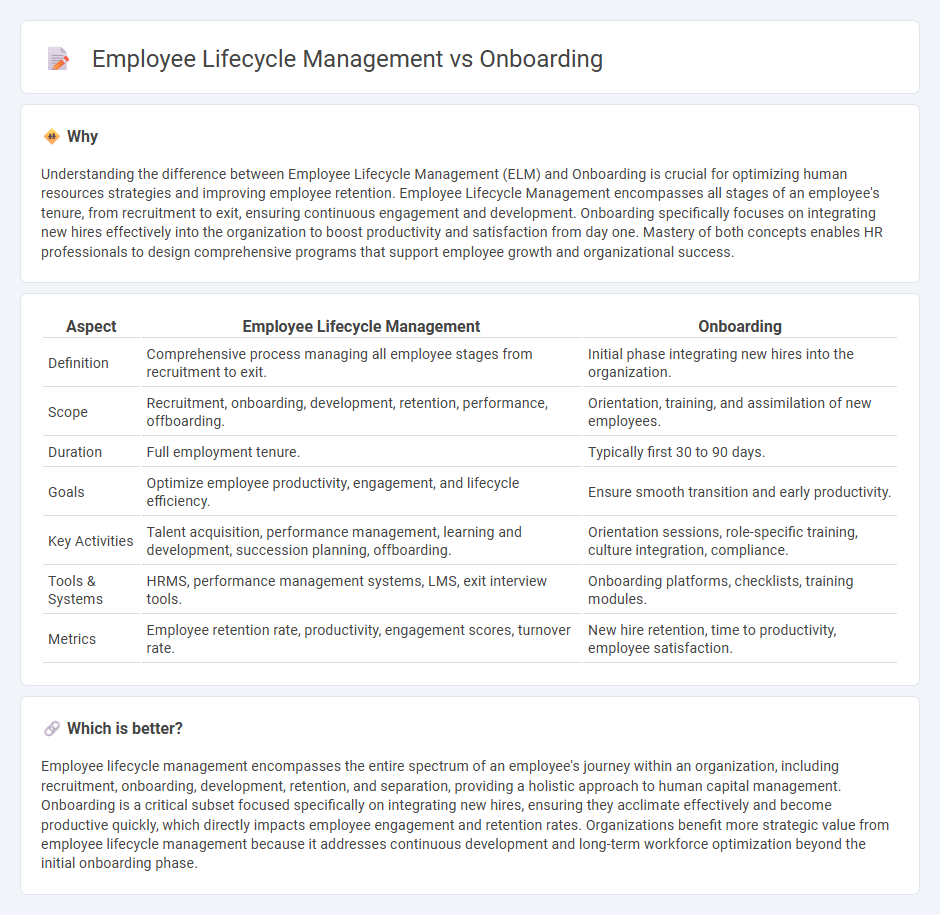
Employee lifecycle management encompasses all stages of an employee's tenure from recruitment to exit, ensuring continuous engagement and development. Onboarding is a critical phase within this cycle focused on integrating new hires effectively into the organization's culture and workflows. Explore the differences and connections between these processes to optimize workforce management.
Why it is important
Understanding the difference between Employee Lifecycle Management (ELM) and Onboarding is crucial for optimizing human resources strategies and improving employee retention. Employee Lifecycle Management encompasses all stages of an employee's tenure, from recruitment to exit, ensuring continuous engagement and development. Onboarding specifically focuses on integrating new hires effectively into the organization to boost productivity and satisfaction from day one. Mastery of both concepts enables HR professionals to design comprehensive programs that support employee growth and organizational success.
Comparison Table
| Aspect | Employee Lifecycle Management | Onboarding |
|---|---|---|
| Definition | Comprehensive process managing all employee stages from recruitment to exit. | Initial phase integrating new hires into the organization. |
| Scope | Recruitment, onboarding, development, retention, performance, offboarding. | Orientation, training, and assimilation of new employees. |
| Duration | Full employment tenure. | Typically first 30 to 90 days. |
| Goals | Optimize employee productivity, engagement, and lifecycle efficiency. | Ensure smooth transition and early productivity. |
| Key Activities | Talent acquisition, performance management, learning and development, succession planning, offboarding. | Orientation sessions, role-specific training, culture integration, compliance. |
| Tools & Systems | HRMS, performance management systems, LMS, exit interview tools. | Onboarding platforms, checklists, training modules. |
| Metrics | Employee retention rate, productivity, engagement scores, turnover rate. | New hire retention, time to productivity, employee satisfaction. |
Which is better?
Employee lifecycle management encompasses the entire spectrum of an employee's journey within an organization, including recruitment, onboarding, development, retention, and separation, providing a holistic approach to human capital management. Onboarding is a critical subset focused specifically on integrating new hires, ensuring they acclimate effectively and become productive quickly, which directly impacts employee engagement and retention rates. Organizations benefit more strategic value from employee lifecycle management because it addresses continuous development and long-term workforce optimization beyond the initial onboarding phase.
Connection
Employee lifecycle management encompasses the entire journey of an employee from recruitment to exit, with onboarding serving as the critical initial phase that sets the foundation for employee engagement and retention. Effective onboarding programs accelerate integration by aligning new hires with company culture, roles, and expectations, reducing time-to-productivity and turnover rates. Integrating onboarding within employee lifecycle management enhances workforce stability and drives long-term organizational success.
Key Terms
Orientation
Orientation is a critical phase within onboarding that introduces new employees to company culture, policies, and job expectations, setting the foundation for long-term engagement. Effective orientation programs improve employee retention and accelerate productivity by addressing both operational and emotional needs during the initial days. Explore how strategic orientation practices enhance overall employee lifecycle management and contribute to workforce success.
Performance Management
Onboarding establishes the foundation for Performance Management by aligning new employees with company goals and expectations from day one. Employee Lifecycle Management extends this process by continuously monitoring, evaluating, and developing performance through regular feedback, training, and career progression strategies. Explore more insights on optimizing employee performance across their entire journey.
Offboarding
Offboarding is a critical phase in employee lifecycle management that ensures a smooth transition when an employee exits an organization, encompassing knowledge transfer, exit interviews, and revocation of access rights. Unlike onboarding, which focuses on integrating new hires, offboarding emphasizes data security, compliance, and preserving organizational knowledge to mitigate risks. Explore comprehensive offboarding strategies to enhance your workforce management and protect your business assets.
Source and External Links
What Is Onboarding? (Definition, Process, Examples) | Built In - Onboarding is the process of integrating a new employee into their role and the company, providing them with necessary tools, knowledge of company culture, policies, and systems to help them succeed from their first day.
Complete Employee Onboarding Guide - SHRM - Onboarding includes orientation, training, and activities designed to help new hires learn about the organization's structure, values, and expectations, often involving tours, informational materials, mentorship, and team-building exercises to foster engagement and integration.
Onboarding - Wikipedia - Onboarding, also known as organizational socialization, refers to the process by which new employees gain the knowledge, skills, and behaviors needed to become effective and committed members of an organization, utilizing methods like formal meetings, training sessions, and cultural immersion.
 dowidth.com
dowidth.com